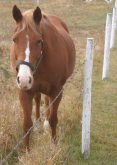The animals’ behaviour is observed to assess stress levels and possible handling improvements that could be made
A team of University of Calgary researchers is attempting to learn how rodeo performances affect horses and bulls bred to buck.
A partnership between the university’s faculty of veterinary medicine and the Calgary Stampede allows a research team to spend each day of the rodeo observing bucking bulls to assess stress levels, humane handling and improvements that could be made to keep animals and riders safe.
The cowboys and handlers are interested in the research and have contributed their observations.
“If the animals are not healthy and happy, they are not going to perform well and the cowboys are not going to get as a good a score,” said veterinarian Jennifer Pearson.
Read Also

Beef check-off collection system aligns across the country
A single and aligned check-off collection system based on where producers live makes the system equal said Chad Ross, Saskatchewan Cattle Association chair.
Ten bulls are used per day plus extras. Contractors bring them in daily and the research team tracks them throughout their time at the Stampede. Cameras are set up at key points to observe their behaviour during the course of the day to see how they behave in the holding pens until they move to the loading chutes, during bucking events in the arena and after they leave the infield.
The research team monitors the animals to see if they seem agitated in the pens, how they interact with each other and how they react to outside stresses. The daily weather is also monitored to see how it affects them.
The bulls are generally in a pen with a herd mate rather than a stranger.
“Some will even bring along bulls to be a buddy bull. He won’t perform but he is a friend to keep the bull calm,” said Pearson.
Zeanna Janmohamed, a second year vet student hired to work with the team, does a daily time budget, in which she watches to see how the bulls spend their day, including standing, lying down, drinking and ruminating.
The Stampede has animal care guidelines, and a full-time animal welfare auditor observes the bulls coming off the trailer and being loaded. She also assesses the welfare of every animal on the grounds.
The university has worked with the Stampede for seven years evaluating and researching animal welfare with subsequent findings used to improve life for the performing animals.
Several years ago when working with horses, it was noticed they were often agitated because people could stand over the pens and watch them. A cover was placed over the area to keep out the gawkers and the horses were calmer as they moved from pens to performance.
“They used to have trouble getting the animals into the loading chute,” Pearson said.
“They found so many people would stand on a catwalk and scare them.”
The team also watches to see how animals react to the noise of crowds and evening fireworks.
“We notice the horses respond more to the fireworks than the bulls. When the fireworks go off, some of the animals do jolt,” she said.
“The novice animals are a bit more startled than some of these animals that come year after year.”
Published papers from past research for scientific journals are being drafted now, said Ed Pajor, an animal welfare specialist at the university.
More rodeos are paying attention to what the Stampede is doing in its animal welfare program.
“One of the things I would really like to happen is that more of the rodeos would start to think about animal care policies and programs to keep track of what is happening to these animals and the handling of these animals,” he said.
People working with rodeo stock should have low stress handling experience and adopt similar practices to what the Stampede has developed.
“There is a lot more that could be done at the local rodeo level,” he said.
Many recommended changes would not cost much money in new investment and training of people, he added.
“I am not saying everyone is rough, but there are things that could be done.”


















